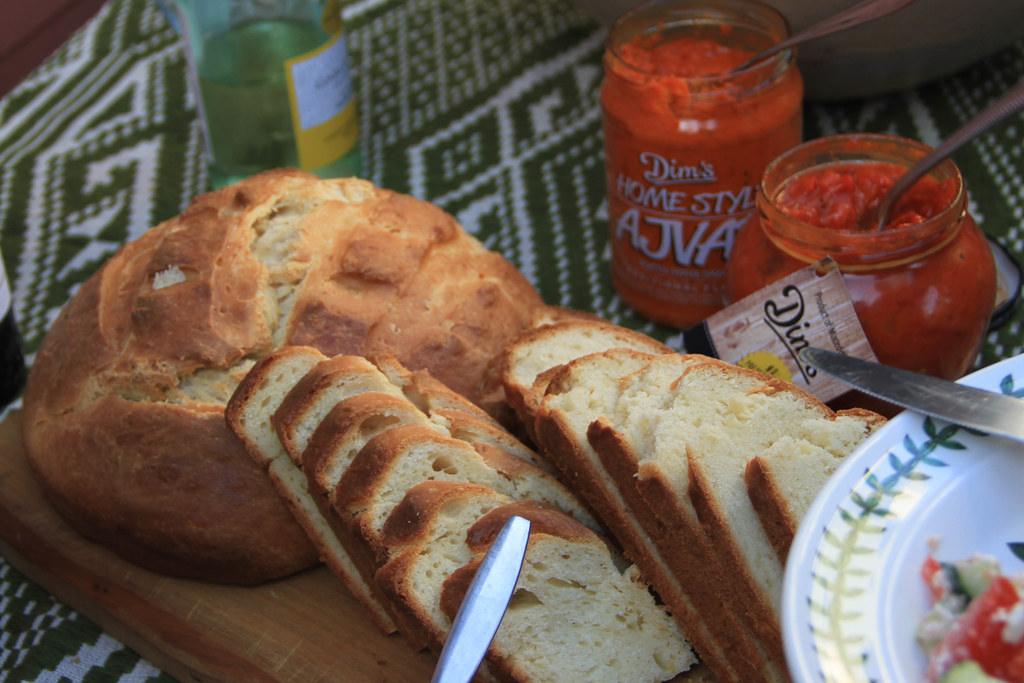Rum punch | Recipe
This is the first punch I’ve seen that says to mix a few days ahead of time and keep at room temperature. It’s also got quite a bit of water. And it was good! A few days of mellowing took the edge of the acidic juices and made for a lovely drink.
Sea moss drink | Recipe
Ever seen “carrageenan” toward the end of an ingredients list? It’s a mucilaginous thickener, found in products ranging from nut milks to cold cuts. And it comes from a seaweed known as sea moss or Irish moss (in fact, carraigín means “little rock” in Irish), which in much of the Caribbean is enjoyed as a drink! Whole pieces of the plant are soaked and simmered until they fall apart, then mixed with various canned milk products, sugar, and in this recipe, lime, cinnamon, and Angostura bitters.
Unsurprisingly, the taste is unfamiliar and, well, quite something. It indeed tastes of the sea; it’s not salty per se but tastes like the ocean smells, and it’s also got a thickness close to a milkshake. I can see how one would grow accustomed to it, but I found it hard to drink the whole glass.
Callaloo soup | Recipe (and domplins)
Most plants that we eat both the seed and leaf of are spices and herbs respectively—coriander/cilantro, dill, fennel, and so on. Mustard greens are a legit vegetable, but the seeds are still spices. Amaranth is the only plant whose leaves and seeds are both eaten at legit scale, and where both are eaten as a true food item rather than a flavoring.
Callaloo is both the name of a variety of amaranth in much of the Caribbean, as well as a stew made from either these or other leaves. As with most dishes made in many places and mostly in home kitchens, recipes vary regionally, by family, and can adapt to what’s on hand. This Vicentian version is big on coconut milk and salted meat, lending richness to contrast the leaves which taste like a nuttier version of spinach. The domplins—that is, dumplings—absorb the flavors and make it all the more filling.
Breadfruit and jackfish | Recipe
I’ve read that breadfruit is fairly large, quite starchy and a bit fluffy when cooked (hence the name), with a faint potato-like flavor. Unfortunately, I’ve only ever encountered frozen sliced breadfruit, and it just turns out unappealingly spongy no matter what I do. Well, until this time, when I came upon some small frozen breadfruit and roasted them on the grill, as is done in St. Vincent and the Grenadines.
Except that they turned into pure charcoal, except for the inside, which was, once again, unappealingly spongy, and went straight to the compost. I hereby swear off ever buying frozen breadfruit again, and I suspect fresh breadfruit ain’t amazing anyway — I see its close cousin jackfruit imported fresh in Asian markets, but have never seen anyone bothering to sell breadfruit the same way.
As far as the jackfish, which is the second half of the islands’ national dish, I could hardly even figure out what kind of fish available to me would be. best to cook. “Jackfish” appears to be a name applied to specimens from several genera of saltwater fish; using photos of the dish with one or two whole small fish as a clue, I ended up going with some Indian mackerel. Fried with a bit of lime and breading, they were tasty, but definitely bare without their traditional breadfruit pairing.
Creamed christophene | Chayote gratin | Recipe
You may have seen this close relative of zucchini in the produce aisle, pale green, roughly pear shaped, with a crease that looks a whole lot like pursed lips. Chayote has a mild nutty flavor, and a texture somewhere between potato and cucumber which holds up to cooking. In the Caribbean it’s known as christophene, and is found in a variety of dishes, including this milky-cheesy casserole. I thought it was fine, but frankly I think it would have been tastier with potatoes.
Arrowroot cakes | Recipe
You might have heard this name in the context of teething biscuits or gluten-free baking. As the name suggests, it’s a starchy root, and it happens to be native to the Grenadines. Baked up into cookies, it has a crumbly, shortbread-like texture, and gets a little gummy in your mouth as it softens, in a satisfying way. Too bad arrowroot is pretty pricey (a one-pound bag of Bob’s Red Mill set me back $10, and you can pay way more than that if you buy it by the tiny jar in the spice aisle), or this is a thing I’d consider putting in my repertoire.














